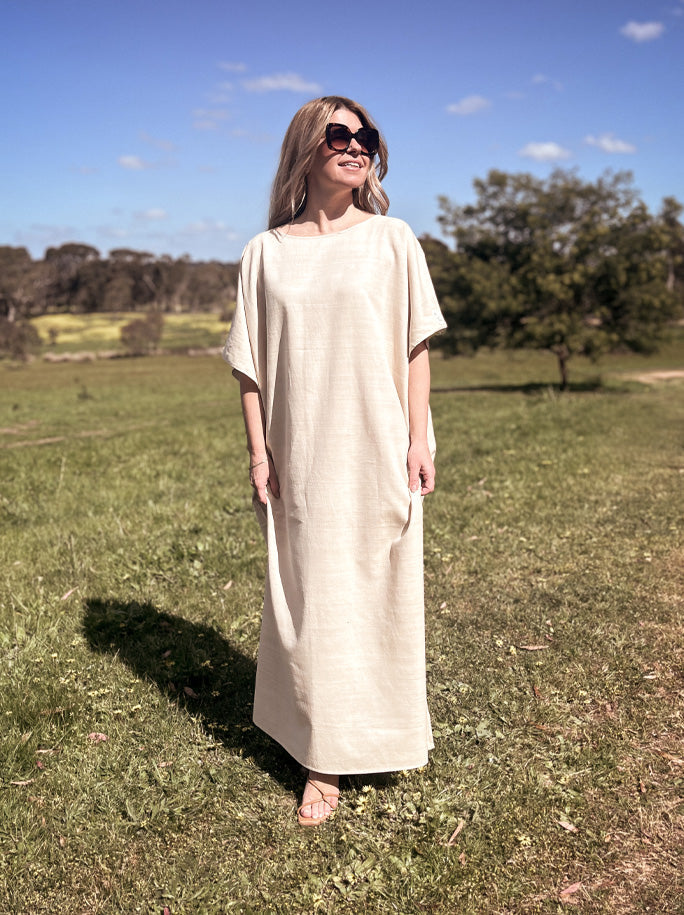What's wrong with bamboo as a textile?
Thanks to greenwashing, bamboo is marketed as a sustainable solution for the textile industry. But its production process into a fabric is where the education is lacking and the facts are frightening.
A big reason why Acala Stem was founded, was due to uncovering how bamboo fabric is made and the damage it causes to the environment. And the irony that it's positioned as sustainable.
The toxic truth about bamboo textile production
Converting raw bamboo shoots into a textile is anything but natural. It's an intensive and chemical-heavy process to produce the fabric. The bamboo pulp is dissolved in a highly toxic chemical solution. Once its cooked, the solution is sent through little holes (a spinnarette) and into a bath of sulfuric acid, where it dries and hardens into strands imitating that of a natural fabric yarn. Any trace of what was a raw and natural fibre has been dissolved.
What effect does this have on the environment?
Bamboo fabric production can emit a poisonous gas and releases chemicals that pollute drinking water, the soil, and the air. This contributes to the number of synthetic fibres escaping through our plumbing systems into our waterways and oceans at a scary magnitude, given the fabric’s high demand throughout the world.
Bamboo grows at such a fast rate that it quickly blocks sunlight and smothers most other wild plants, stopping them from growing or regenerating, particularly destroying underground eco-systems with its fast-growing root system.
Why bamboo fabric can never be certified GOTS
Bamboo or bamboo rayon is no longer a raw, natural or organic fibre. This is why the Global Organic Textile Standards (GOTS) will never certify bamboo textiles, even when the original bamboo plant is grown organically.

The great antibacterial myth
Another unregulated field is the antibacterial claims made by brands selling bamboo textiles. Bamboo as a natural plant has high antibacterial properties. But these properties are destroyed through its heavy process into a fabric.
"A good tip is to ignore any antibacterial claims altogether, unless they have published their original testing certificates, or go straight to the published academic journals to read the facts."
Source: https://global-standard.org/q-and-a#useofbamboo
How does Acala Stem's lotus silk compare to bamboo?
- Lotus silk remains as a raw fibre, therefore retaining its original nutrients as a plant.
- Lotus silk yarn is unable to be mass-produced with automation, which adds more value to every piece of lotus silk, because you know every piece – from an eye pillow or a face washer – is truly unique and handcrafted.
- Unlike bamboo, cotton or hemp, lotus doesn’t need to be watered, as its grown underwater in its natural environment, and harvested after SE Asia’s rainy season.
- Lotus silk has a very high wholesale price tag compared to bamboo. Bamboo can be purchased wholesale for as low as $1AUD a metre, compared to pure lotus silk at around $300AUD a metre.
- One metre of bamboo textile can take up to 1000 litres of water in its production process. Lotus silk requires zero water.
- Lotus silk retains the lotus flower's antimicrobial properties with an activity clinically proven at more than 99%. Bamboo textiles have failed to retain the original material’s antimicrobial activity. Have you ever noticed a bamboo face washer grow tiny dots of black mould?
- Finally, unlike bamboo textiles, lotus silk won’t melt when exposed to high temperatures.
The dangers of misleading sustainability messaging
A lot of new parents are purchasing bamboo textile products for the infants, under the trust that it's a natural and gentle fibre, but this couldn't be further from the truth. The softness of bamboo rayon has a luring impression of gentleness and purity, but infants should only be exposed to fibres with as less chemical processing as possible, preferably with no dyes or bleaches, and these are very hard to find. Which is why we launched a lotus silk range designed especially for infants, so parents have the assurance that no harmful chemicals have been used, and the fabric has been handcrafted and traditionally woven with no chemicals, bleaches or dyes.
Deciphering what’s really “sustainable”
Soon, there will be legislation preventing brands labelling textiles such as bamboo or bamboo rayon as “sustainable”. The terminology is used so loosely and by every brand in existence now, making it very difficult for consumers to decipher what's really sustainable. Therefore the truly kind fabrics such as lotus silk have their sustainability message diluted due to the greenwashing noise. We’ve even seen new polyester yoga pants labelled as “sustainable”, which is heartbreaking for the environment and the mislead consumers.
Preventing mass-production and wastage
The only way to create an organic, natural fabric, that’s zero harm to the environment, is to handcraft it very slowly and carefully, with no chemicals or water and no machinery. Even the removal of the raw materials from the earth needs to be performed by hand.
This is what sets lotus silk apart from all other fabrics.
For information on our clinical testing and to view certificates, visit here




